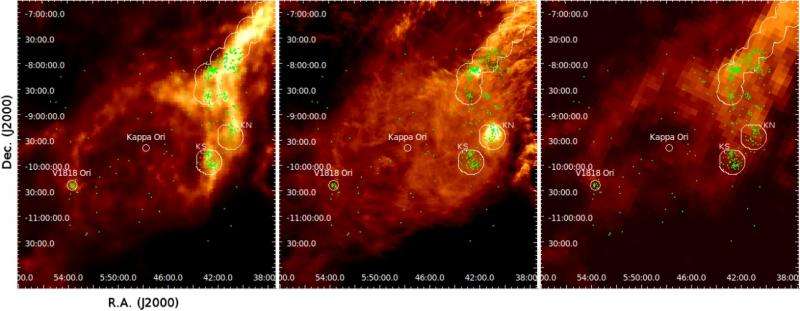March 11, 2016 report
Star-forming ring spotted around distant supergiant star Kappa Ori

(Phys.org)—Astronomers have spotted a star-forming ring around a distant star Kappa Ori, located at the south-eastern corner of the constellation of Orion. The star, also known as Saiph, is a supergiant with a mass of approximately 15 solar masses about 650 light years from Earth. According to the scientists, the newly-detected ring contains several groups of stars. The results were published in a paper on Mar. 1 in the arXiv journal.
The astronomers, led by Ignazio Pillitteri of the Harvard-Smithsonian Center for Astrophysics in Cambridge, Massachusetts, have used the European Space Agency's (ESA) XMM-Newton spacecraft to conduct X-ray observations of two regions near Kappa Ori containing young stellar objects (YSO). They detected a total of 121 interesting X-ray sources that appear to be stars with disks, protostars and candidate class III stars. They determined that these YSOs form a distinct star-forming shell between 16 and 26 light years in diameter.
Very young stars are very powerful emitters of X-rays. Thus, X-rays are often used to discover young stars embedded in gas and clouds, where optical and infrared observations fail to deliver detailed information. This is because X-rays can penetrate these clouds much better than optical photons.
Pillitteri and his colleagues used the X-ray fluxes to compare the emission from stars near Kappa Ori to that in the filamentary dark cloud complex named L1641, observed with the Survey of Orion A with XMM-Newton and Spitzer (SOXS). It was surprising and challenging to discover that there are groups of young stars near Kappa Ori that are significantly more luminous than their siblings in L1641.
"In general, the study of the Orion cloud was challenging because recent observations have demonstrated that this 'nursery' of stars has a complex structure made of nested bubbles produced by the interaction between the cloud and supernovae explosion or winds from massive stars. My collaborators and I have started to study the Orion A nebula and L1641 in X-rays with SOXS. The research regarding Kappa Ori is a follow-up of that study," Pillitteri told Phys.org.
According to the authors of the paper, the ring of stars with disks is visible in mid-infrared data, as well as in far-infrared and CO line maps. However, the ring is in projection toward the tail of Orion A and the more distant Mon R2 star-forming region; thus, it is not easy to disentangle the single structures along the same line of sight.
The existence of this ring yields important information about star formation processes. It supports a scenario in which stellar winds from a massive star at the center of a gas cloud can sweep and compress the gas around it. The gas can then collapse and give birth to stars. Of course, further observations are needed to study this scenario and also to get more insights on these interesting young stellar objects.
"There is at least one other field that we want to study, containing a group of young stars with disks. We want to conduct follow-up observations with optical spectroscopy that can be useful to determine photospheric temperatures, gravity, chemical composition and the age of these stars. We also wait for GAIA (Global Astrometric Interferometer for Astrophysics) spacecraft data release that would benefit to study of the whole Orion complex," Pillitteri concluded.
If confirmed by GAIA or other future measurements, this ring will be one of several nested shells found in the Orion-Eridanus superbubble. It could therefore be a great example of star-formation mechanisms where massive stars sweep up the gas and dust in the hot interiors of superbubbles to form shells of cold, star forming gas.
More information: A star forming ring around Kappa Ori 250 pc from the Sun, arXiv:1603.00205 [astro-ph.SR] arxiv.org/abs/1603.00205
Abstract
X-rays are a powerful probe of activity in early stages of star formation. They allow us to identify young stars even after they have lost the IR signatures of circumstellar disks and provide constraints on their distance. Here we report on XMM-Newton observations which detect 121 young stellar objects (YSOs) in two fields between L1641S and κ Ori. These observations extend the Survey of Orion A with XMM and Spitzer (SOXS). The YSOs are contained in a ring of gas and dust apparent at millimeter wavelengths, and in far-IR and near-IR surveys. The X-ray luminosity function of the young stellar objects detected in the two fields indicates a distance of 250-280 pc, much closer than the Orion A cloud and similar to distance estimates of κ Ori. We propose that the ring is a 5-8 pc diameter shell that has been swept up by κ Ori. This ring contains several groups of stars detected by Spitzer and WISE including one surrounding the Herbig Ae/Be stars V1818 Ori. In this interpretation, the κ Ori ring is one of several shells swept up by massive stars within the Orion Eridanus Superbubble, and is unrelated to the southern portion of Orion A / L1641 S.
© 2016 Phys.org





















